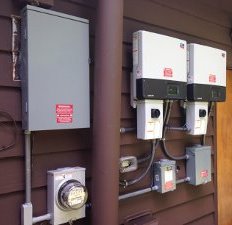
Imagine a power grid where each customer is also a producer, where electricity used by a neighborhood was generated cleanly and efficiently in that same neighborhood. Using net metering technology, households with power generation systems (solar panels, windmills, etc.) can sell unused electricity back to the grid, where it can be used to power nearby buildings. At present, 43 states, as well as Washington D.C. and Puerto Rico, have adopted policies that allow for net metering.
The concept of each city block generating enough electricity to power itself is an unrealistic ideal, because almost all households and buildings with on-site power generation still consume much more energy than they produce. However, the concept of an integrated network of distributed individual producers is already starting to become a reality.
The Technology
Net energy metering (NEM) technology is an essential component of any household solar installation. Because of the intermittent nature of the sun’s ability to produce power, a consumer would have to use the electricity generated by the solar panels as it was being produced. Unfortunately, the peak solar production is during the middle of the day when most residents are away at work. Without a way to store the energy, it is lost. NEM technologies utilize a 2-way meter which tracks the electricity supplied to the house by the power companies, as well as the extra electricity generated by the solar panels when production exceeds demand. In effect, the meter runs backwards while your house produces excess energy, crediting your account for the electricity that is put back into the grid. Simply put, if your power company charges you $0.10 per kWh and your solar array produces an extra 10 kWh during the day that you do not use, you save $1.00 off your electric bill. This is a simplified calculation, many utility companies have other savings and charges associated with net metering, a few of which will be discussed later on.
The Impacts
In addition to working towards the ideal of a coordinated societal network of renewable electricity production, net metering policies have benefits for both individual consumers and utility companies. Consumers see increased savings on their bill as a result of their on-site generation, drastically reducing the payback period for installing renewable systems.
According to a white paper published by Keith McAllister, a member of the Interstate Renewable Energy Council (IREC), the average capacity factor of U.S. power plants is about 55%. This means that 45% of the plant’s power capabilities go unused most of the time, and therefore roughly 45% of capital dollars spent to construct these plants was only necessary to meet peak demand. A related white paper by IREC members Jason Keyes and Joseph Wiedman states that about two-thirds of total power generation comes from coal, nuclear, and hydropower plants which are constantly in operation. During peak business hours (usually during the day), these facilities increase their output, and additional natural gas-burning facilities are “turned on” to accommodate the extra demand. With more distributed generation facilities, the need for these natural gas plants is lessened. This means that the peak load, the maximum amount of power that the utility would need to produce, is reduced.
By closely monitoring the demand for electricity based on time of day and/or time of year, utility companies can offer an option for time-of-use pricing, a variable rate depending on the time, day, or month that electricity is used. Time-of-use pricing would mean that customers would pay more during peak demand hours, and less during off-peak hours. Those opting for time-of-use would tend to consciously decrease their electricity use during peak hours in order to save money, thus lessening the peak load on the utility.
In addition to the reduction in peak loads, the transportation losses will decrease if electricity is produced closer to where it is used. Due to resistance in the wires that make up power lines, between 5-10% of the power generated at the plant site is lost by the time the electricity reaches the point where it is used. If electricity only has to travel about 1000 feet down a street instead of 5 miles across a county, less of the generated energy will be lost along the way.
By reducing peak loads and average transmission distances, the grid can operate under less stress. Individual generators, wires, and other parts will last longer if they are not being pushed to their limit of operation all the time. With less strain on the grid, the need for construction of new power plants and other replacement materials is reduced. This means that, in the long run, power companies will be able spend less money if plants and parts last longer. This reduction in cost is the main benefit utilities see from net metering policies.
While having individual, distributed generation facilities lessens the strain on the power company, this type of customer-producer relationship also reduces the amount of electricity that energy companies are able to sell. The cost benefits from lowered grid stress are projections and speculations, while reduced electricity sales are easily seen each month. Because of this, many power companies are reluctant to allow any more customer benefits to net metering than those required by state law. For example, many utilities charge a flat fee associated with NEM installation and limit the ability to rollover any excess energy production across billing periods (For more details on power companies’ rate changes, see the links below).
The Future
In addition to a decreased electric bill, consumers with NEM systems are helping move towards the future of the power grid. As more and more household generation systems are installed, the role of utility companies will change. Instead of being the sole producers and sellers of electricity, utility companies will serve the purpose of maintaining the grid, supplying reserve power when weather-dependent systems do not operate, and most importantly, managing the flow of electricity to maximize the efficiency of the entire process. Power companies would use real-time metering techniques and established models to determine which generation sites/groups of sites would serve which consumption sites.
By installing your own net metered solar array, you can be a part of the movement to reduce not just your own reliance on “dirty” sources of electricity, but your community’s reliance as well. A well-coordinated network of renewable generation systems will result in neighborhoods that are much more energy-efficient, even self-sustaining. To achieve this in the coming decades, consumers and utilities will both need to continue to develop approaches that are flexible, progressive, and coordinated. While the overall ideal may not be attainable at the present time, each small step contributes towards this greater goal.
Do you have more questions about energy metering in the United States? Contact YellowLite today. We're happy to answer your questions.
By Mattie DeDoes



